Mastering Avocado Salsa: A Culinary Journey
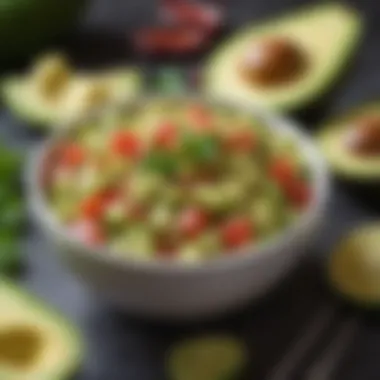
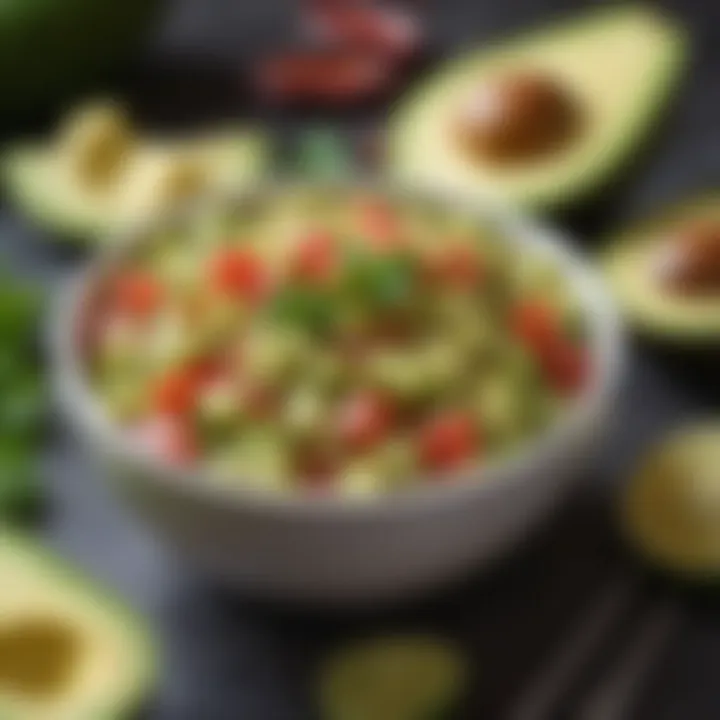
Intro
This article focuses on avocado salsa, a dish celebrated for its flavor and simplicity. This culinary guide aims to explore the preparation process, ingredient selection, and variations of avocado salsa, making it a worthwhile addition to any kitchen. In today’s fast-paced world, where time is often a luxury, a quick-to-prepare recipe, like this one, presents itself as an ideal solution for busy cooks.
Whether you’re creating a fresh topping for tacos or a flavorful dip, the versatility of avocado salsa stands out. The key aspects of making a successful salsa will be discussed, along with time-saving tips, substitutions for dietary needs, and an understanding of its nutritional benefits. The journey through preparing this dish ensures that flavor, efficiency, and health can coexist mm.
Recipe Highlight
Avocado Salsa offers a delightful balance of creaminess, acidity, and zest.
- Essential Ingredients:
- Estimated Time: 15 minutes
- Servings Yield: Approximately 4 servings
- Ripe avocados
- Fresh tomatoes
- Red onion
- Jalapeño peppers
- Fresh lime juice
- Cilantro
Step-by-Step Instructions
Making avocado salsa is straightforward and accessible.
- Prep Your Ingredients:
Start with ripe avocados, slicing them in half and removing the pit. Use a spoon to scoop out the flesh. - Chop the Avocados:
In a bowl, mash or chop the avocados to your desired consistency – leave some chunks for texture. - Add Other Ingredients:
Finely dice tomatoes, red onion, and jalapeños. Add these to the chopped avocados. - Incorporate Seasoning:
Pour fresh lime juice over the mixture and gently fold in chopped cilantro. Season with salt and pepper to taste. - Adjust Flavor:
Taste the mixture and adjust lime juice or seasoning as needed.
Techniques like ensuring the avocados are ripe can prevent any bitterness and enhance creaminess. A common mistake is over-mashing; keeping some chunks maintains a good texture.
Variations and Substitutions
Customization offers flexibility. Consider the following ideas:
- Add Fruits: Fresh mango or pineapple can add sweetness.
- Spice Level: Include more jalapeño or a dash of hot sauce for extra heat.
- Different Herbs: Explore using parsley instead of cilantro for an alternative flavor.
- Serve in Different Ways: This salsa pairs well with tortilla chips, grilled meats or as a topping over salads.
Time-Saving Cooking Tips
Efficient preparation can speed up the cooking process.
- Chop Ahead: Pre-chop your vegetables and store them in the fridge. They are ready to be added when making salsa.
- Use a Food Processor: For quick chopping of ingredients, consider a food processor, where you can combine flavors swiftly.
- Batch Cooking: Preparing larger quantities allows for multi-meal efficiency. Store in an airtight container in the fridge for easy access.
Nutritional Information
Each serving of this avocado salsa contains around 120 calories, primarily sourced from healthy fats in the avocado.
Key nutrients include:
- Fiber: Promoting digestion.
- Vitamins: C and K are well represented, benefiting overall health.
- Suitable Diets: The recipe is vegan and gluten-free, making it accessible for many eating plans.
Understanding these nutritional elements can help one appreciate not just the taste but also the health benefits the dish provides.
Avocado salsa, as a fresh and flavorful accompaniment, is not just a dish; it is a step towards a healthier lifestyle.
Intro to Avocado Salsa
Avocado salsa is not just a simple condiment; it encapsulates vast potential for enhancing a myriad of dishes. This section emphasizes the importance of understanding avocado salsa, touching upon its ingredients, preparation methodologies, and cultural origins.
In a world bustling with diverse culinary artistry, the ease of making avocado salsa makes it a valuable skill for any home cook.This dish often acts as a bridge connecting traditional tastes with modern adaptability, demonstrating how la-verdura can infuse depth to any meal.
What is Avocado Salsa?
Avocado salsa is typically a combination of mashed or diced avocados with other complementary ingredients, resulting in a flavorful mixture. The dish predominately features fresh avocados as its star component, renowned for their creamy texture and eminent health benefits. Additional ingredients like tomatoes, onions, lime juice, and cilantro often find their way into this mixture, enriching both flavor and nutritional content.
The appeal of avocado salsa stretches beyond simple flavor. It is a food versatile enough to accompany tacos, grilled meats, or even as a spread on sandwiches. This ease of use aligns with growing trends of quick, nutritious meals, particularly for busy individuals who value culinary simplicity without compromising on taste.
Historical Context and Cultural Significance


Exploring avocado salsa involves diving into its historical context and cultural relevance. The origins of this dish trace back to regions in Central and South America, where avocados have long been a staple food. Ancient civilizations derived crucial nutritional value from avocados. As culinary practices evolved and evolved into modern dishes, salsa made with this green fruit inevitably surfaced, thus creating a popular cultural phenomenon.
In Mexico, salsa is an essential component of many dishes and holds social significance as well, often enjoyed in gatherings and festivities. As culinary exchange has increased globally, variations of avocado salsa emerge, adapting to regional tastes while keeping the fundamental essence intact. Today, its role persists— a convergence of history, culture, and simplicity that reflects modern food practices.
The timelessness of avocado salsa captures not just flavor, but a narrative through the ages, linking tradition with contemporary dining.
Ingredients for Avocado Salsa
Understanding the ingredients for avocado salsa is crucial for crafting this dish successfully. Each component plays an essential role in achieving not only the desired flavor profile but also the texture that complements the fresh avocado. The right selection will elevate the experience, making it suitable for various occasions or simply as a personal indulgence. Here is a closer look at the primary ingredients.
Fresh Avocados: Selection and Ripeness
Choosing fresh avocados is the keystone of this recipe. The ripeness of avocados can greatly impact the creaminess and flavor of the salsa. You want to look for avocados that yield slightly to gentle pressure. This tactile check indicates that they are ripe and ready to consume. Hass avocados are often preferred due to their rich flavor and buttery texture.
When selecting, avoid those with large blemishes or dark spots, which may indicate overripeness or spoilage. Keeping avocados at room temperature until ripe, then refrigerating gives control over timing.
Accompanying Ingredients Overview
The supporting ingredients in avocado salsa bring vibrancy and balance to the dish.
Tomatoes
Tomatoes add both color and acidity, each playing a vital role in enhancing the salsa's overall flavor. A popular choice, roma tomatoes offer firm texture while soaking in the flavorful juices without becoming mushy. Their natural sweetness coupled with slight acidity makes them critical in offsetting the creaminess of avocados.
Onion
Using onion delivers sharpness that cuts through the richness of the avocado. Red onion is often favored in salsa for its milder taste and vibrant color. It can be diced finely to provide a crunch while also marinating in and blending with other ingredients. Although some may find raw onion strong, its contribution to the depth of flavor is essential.
Cilantro
Adding cilantro introduces freshness that elevates the dish further. This herb is notable for its ability to bring out the bright sounds of the other ingredients. However, its distinctive flavor is polarizing. Some enjoy its zest, while others may find it too overwhelming. Utilizing fresh cilantro complements the existing flavors rather than overpowering them. It is best to chop finely to mix uniformly throughout the salsa.
Lime Juice
Lime juice is instrumental for acid balance. It enhances flavors, restoring freshness lost from sitting or heat. The tartness sharpens the inherent sweetness while staving off browning in avocados, which is practical and keeps the salsa looking appetizing.
Salt and Pepper
The simple ingredients of salt and pepper are essential. Salt concentrates and amplifies each ingredient's natural flavors. While pepper is a beneficial addition, bringing some heat, it is generally adjusted to taste. Utilizing Himalayan pink salt or freshly ground black pepper enhances experiences with nuanced flavors.
In summary, each ingredient builds on the overall profile of the avocado salsa. Careful selection and proper use assures concocting a savory experience filled with various textures.
Through methodical assembly of these elements, you set a foundation for creating an impressive fresh and healthy salsa. The ingredients, when combined with discernment, promise a harmonious balance that is fulfilling and delicious.
Preparation Steps for Avocado Salsa
Understanding and executing the preparation steps for avocado salsa is a significant facet of mastering this dish. The importance of these steps cannot be overstated, as they are essential for achieving that harmonious blend of flavors and textures. A thoughtful approach to preparation allows one to elevate a simple recipe into a carefully crafted food experience. Following structured steps improves efficiency in the kitchen and brings the joyful assurance that the resulting salsa will be distinguished by quality.
Step-by-Step Guide
Following a clear, step-by-step guide is crucial when making avocado salsa. The recipe is straightforward, yet details matter. Here’s a succinct breakdown:
- Choose your avocados: Use ripe avocados for creaminess.
- Prepare the vegetables: Dice tomatoes, onion, and cilantro to ideal sizes.
- Mix the ingredients: In a bowl, combine the diced avocados, tomatoes, onions, and cilantro gently to maintain texture.
- Add seasonings: Squeeze fresh lime juice and sprinkle salt and pepper to taste.
- Taste and adjust: It's important to sample. Adjust flavors as necessary for balance.
- Allow flavors to meld: Let the salsa sit for a few minutes before serving for enhanced flavors.
This structured approach not only aids in consistency but also invites creativity to fine-tune the dish to personal preferences.
Kitchen Tools and Equipment Needed
Having the right tools can greatly enhance the preparation process:

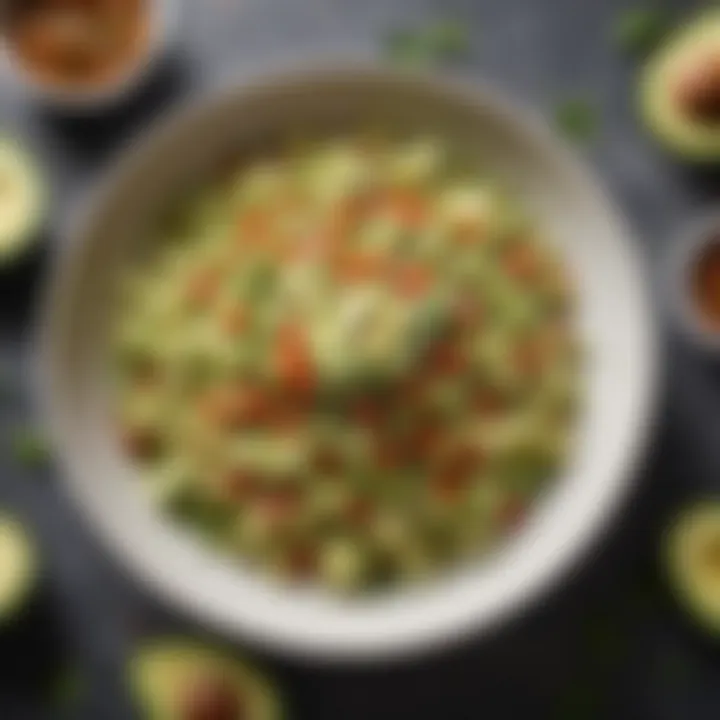
- Cutting Board: Opt for a stable board for stock precision.
- Chef's Knife: A sharp knife makes dicing more efficient and precise.
- Mixing Bowl: Choose a bowl large enough to combine all ingredients without overflow.
- Citrus Juicer: Helpful for extracting maximum juice from the lime with ease.
- Spoon: To fold the mixture without mashing.
These tools streamline the process, minimize mess, and ensure that each ingredient retains its qualities. Easy access to reliable equipment enables time-sensitive cooks to prepare the dish more quickly and enjoyably.
Tips for Perfecting Avocado Salsa
Tips for perfecting avocado salsa are crucial to achieving a dish that not only satisfies but also excites the palate. A successful avocado salsa hinges on various considerations, including flavor balance, texture, and freshness. These elements collectively contribute to a salsa that acts as an appealing complement to a range of dishes. Applying the following tips can enhance flavor and ensure satisfactory enjoyment.
Balance of Flavors
Achieving flavor balance in avocado salsa is essential. Each ingredient plays a vital role in creating a harmonious taste profile. Fresh avocados provide a creamy texture but can be relatively bland. Thus, incorporating ingredients like juicy tomatoes, pungent onion, and aromatic cilantro must be methodically measured.
Here are some key points to consider:
- Acidity: Lime juice enhances brightness. Adding just the right amount is necessary to elevate flavors without overpowering the avocados. Typically, the juice of one lime should suffice for two ripe avocados.
- Salt and Pepper: These seasonings draw out flavors, so don’t overlook them. A pinch of salt before mixing gives time for the flavors to blend, resulting in smoother and richer taste development.
- Heat: If you desire spice, consider fresh jalapeños or serrano peppers. The level of heat should align with personal preference; start with a small amount and increase gradually.
It is significant to taste and adjust while preparing salsa. This practice helps in identifying any deficits or overwhelming notes. It makes sure that the end result shows neither too much acidity nor dullness.
Texture Considerations
The mouthfeel of avocado salsa elevates the eating experience. A successful salsa features a pleasant contrast between creaminess and it’s chopped ingredients. This textural interplay excites the palate.
When mixing textures, be aware of these factors:
- Chopping Techniques: Use sharp knives to slice rather than to mash the ingredients. For example, diced tomatoes and onions provide a crunchy element that can balance the soft, creamy avocados successfully.
- Mashing the Avocados: Depending on desired consistency, your avocados can be fully mashed for a smoother salsa or left chunky for added texture. A balance bwtween the two extremes caters to various preferences.
- Ingredient Preparation: How you cut and unfold each ingredient imparts different tactile impressions. For instance, a finely chopped onion offers bolder taste bursts compared to thicker tones.
Adjusting and testing texture decisions throughout preparation is critical for creating a salsa that carries satisfaction.
Storage and Freshness Tips
Proper storage techniques are vital to retain the freshness of avocado salsa. Since avocados brown quickly when exposed to air, attention to storage methods pays off.
Here are some steps to ensure optimal freshness:
- Air Tight Containers: Always store salsa in an airtight container. This minimiezimizes the oxidation that causes browning. If possible, use containers made of glass for better sealing.
- Layering Lime Juice: If you allow the salsa to sit before serving, drizzling additional lime juice on top will form a barrier against the air. Furthermore, it gives a mild zing to the salsa when using later.
- Short-lived product: Note that avocado salsa tastes best within 24 hours of making it, although it may be stored in the fridge for longer. Assess quality with simple sensory checks before using.
Following these strategies help retain quality while permitting immediate joy with this delightful dish. With the right balance of flavors, textures, and a focus on freshness, avocado salsa shines in any culinary setting.
Serving Suggestions
Serving suggestions elevate the experience of enjoying avocado salsa. This section focuses on integrating avocado salsa into various meals and occasions, highlighting its flexibility. Effectively pairing dishes can enhance flavor harmony.
Pairing with Dishes
Avocado salsa shines when paired thoughtfully with different dishes. Here are some complimentary match-ups:
- Tacos: Drizzle avocado salsa over grilled chicken or fish tacos. The creaminess balances well with the spiciness of salsa or hot sauce.
- Grilled Meats: Serve alongside grilled steaks or kebabs. The fresh, vibrant nature of the salsa punctuates richer flavors.
- Salads: Transform your regular salad by using avocado salsa as a dressing. It adds depth without dominating.
- Nachos: Use as a topping for baked nachos to introduce a mild counterpart to cheese and jalapeños;
- Crispy Tortilla Chips: For a simple appetizer or snack, serve with tortilla chips, resulting in effortless enjoyment.
With various choices, pick what suits your meal or occasion best. While serving, consider the contrast in textures and flavors creating something memorable.
Presentation Ideas
Visually appealing presentations make a notable impact on any dish. Here are some tips to present avocado salsa beautifully:
- Serving Dishes: Opt for white or clear glass bowls. This choice helps showcase vibrant colors of the salsa.
- Garnishes: Hang a cilantro sprig or lime wedge on the bowl's edge to add a pop of color. A slice of chili can make the presentation more enticing.
- Layering: For larger gatherings, create a layered dip. Place avocado salsa at the bottom, and layer it with black beans and cheese topping. Use a transparent container; this visually demonstrates richness in flavors.
- Plate Decoration: Drizzle some lime juice around the plate's edge for a professional touch. This strategy enhances not only aesthetics but flavor.
Using these choices, serve avocado salsa with care. A carefully plated dish appeals to the senses before the first bite is taken.
Engaging presentation not only enhances the dining experience but also expresses thoughtfulness towards your effort in preparing this delicious dish.
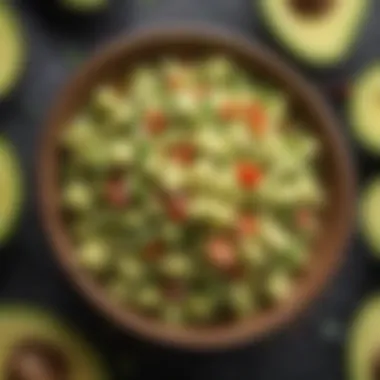
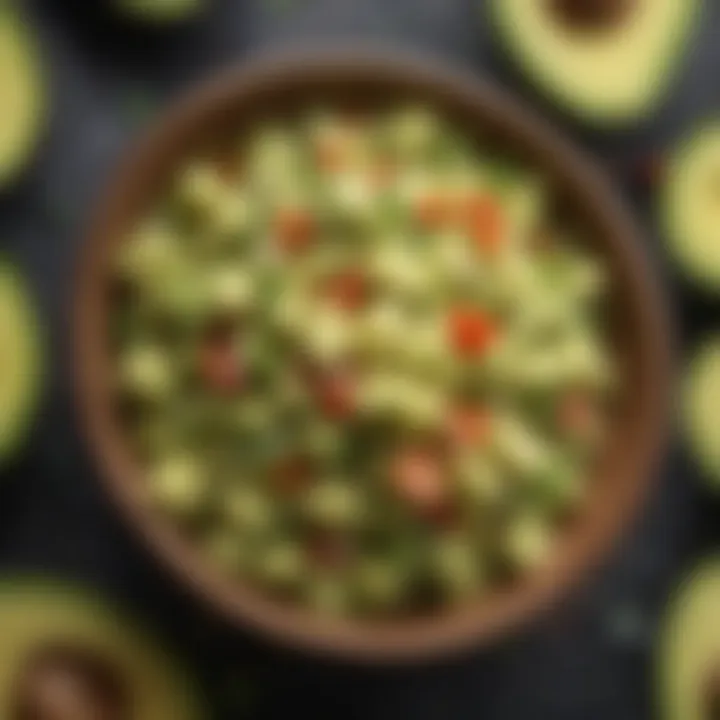
Variations of Avocado Salsa
Exploring the various versions of avocado salsa is essential for embracing the versatility of this dish. Variations allow cooks to personalize flavors that accentuate certain preferences. Each modification brings out diferent aspects of the salsa, catering to varying palates. This section will identify unique styles to inspire both eclectic dinner parties or simple family meals.
Spicy Avocado Salsa
Spicy avocado salsa has garnered a loyal following among those who enjoy a punch of heat in their culinary creations. The core involves traditional avocado and fresh ingredients; however, unique components transform the taste profile comprehensively. Consider incorporating jalapeños, habaneros, or serrano chiles depending on your comfort with spiciness.
Increasing the chile amounts or using hotter varieties notably enhances the flavor and excitement of the homemade salsa. The burn intensifies while contrasting the creamy texture of the avocados. Additionally, this salsa makes for an excellent companion for grilled meats or as a topping for burgers.
Here are a few key ingredients to enhance your Spicy Avocado Salsa:
- Fully ripe avocados
- Finely chopped jalapeños
- Fresh lime juice
- Diced tomatoes
- Chopped cilantro
- Salt and black pepper to taste
Experimenting with the heat level and exploring different pepper varieties can intimate dazzling personal styles. A balance between spice and coolness enhances overall enjoyment.
Fruity Avocado Salsa
On the other hand, fruity avocado salsa brings a refreshing twist to the table. This variation incorporates seasonal fruits, easing the heaviness of traditional salsas. Fruits like mango, pineapple, or citrus can emerge as delightful complements. These accents brighten the dish, offering a good counterbalance to the rich flavor of the avocado.
Assembling a fruity salsa encourages creativity, allowing cooks to investigate the right balance of sweet and savory. A splash of lime juice over the fruit guarantees fresh vibes augments every bite.
Consider using:
- Ripe avocados
- Diced mango or peach
- Diced cucumber for crunch
- Chopped basil or mint
- Lime or lemon juice for acidity
This variation pairs beautifully with seafood or chicken. Additionally, shelved against light nachos, fruity avocado salsa builds unexpected layers of zesty flavor.
Exploring these variations showcases the flexibility of avocado salsa, enhancing social dining opportunities. A small update to the ingredients can stimulate expansive culinary experiences.
Nutritional Benefits of Avocado Salsa
Avocado salsa is not only a delightful culinary experience but also carries numerous nutritional advantages that make it an exceptional addition to any diet. Understanding these benefits helps elevate this dish from a mere condiment to a health booster. The relevance of nutritional benefits in this article lies in crafting a dish that is simple yet packed with essential nutrients.
Health Benefits of Avocados
Avocados are the cornerstone of avocado salsa, and their health benefits are numerous. First, they are high in healthy monounsaturated fats. These fats have been linked to improved heart health by lowering bad cholesterol levels. Consuming avocados may also support overall cardiovascular health, helping to reduce blood pressure.
In addition, avocados are rich in essential vitamins and minerals. They contain vitamins E, C, B6, and potassium, each playing a critical role in bodily functions. Vitamin E is essential for skin health and serves as an antioxidant, while vitamin C boosts the immune system. B6 helps in brain development and function, and potassium is vital for maintaining normal blood pressure.
Moreover, avocados are a good source of fiber. A high-fiber diet is linked to improved digestion, reduced risk of chronic diseases, and better weight management. Each scoop of avocado salsa supports not just flavor but also your daily nutritional needs. Even when enjoyed in moderation, they contribute to overall health and wellness.
Dietary Considerations
When it comes to dietary considerations, avocado salsa accommodates a variety of diets. It is naturally gluten-free, making it ideal for individuals with gluten sensitivities. The abundance of fresh vegetables swapped in the recipe provides necessary nutrients without adding excessive calories.
Furthermore, those following a vegetarian or vegan lifestyle can benefit immensely since the ingredients don’t include any animal products. Avocado salsa can be a fulfilling addition to uninterrupted meals or enjoyed as a light snack.
For those managing their caloric intake, it's important to note the healthy fats from avocados. While these fats are beneficial for health, they also provide higher calorie density than other vegetable counterparts. Thus, portion control plays an essential role in maintaining a balanced diet. Incorporating avocado salsa can provide rich creamy flavor without compromising nutritional objectives. It caters to diverse dietary needs while enhancing the enjoyment of meals.
Closure
The exploration of avocado salsa proves to be both enlightening and essential for those who appreciate the art of cooking. This article reflects on the importance of understanding this dish, from its nutritional benefits to its culinary versatility. Recognizing avocados as a powerhouse ingredient enriches both meals and health, supporting a balanced diet that many strive for.
Recap of Key Points
- Freshness is Key: Selection of ripe avocados ensures a smooth and flavorful salsa.
- Harmonious Flavors: A balance of tomatoes, onions, cilantro, and lime enhances the overall taste.
- Texture Matters: The right texture enhances the eating experience; chopping and mixing require attention.
- Nutritional Value: Avocado offers healthy fats, vitamins, and nutrients that contribute positively to health.
- Versatile Applications: Avocado salsa can accompany various meals from tacos to grilled meats or be enjoyed alone as a dip.
Encouraging Experimentation with Avocado Salsa
It is clear that the foundation for a basic avocado salsa is just the start. Cooks are encouraged to explore different variations that cater to personal taste. Spicy additions, such as jalapeños or chipotle, amplify heat for those who enjoy a kick. Experimenting with fruits, like mango or pineapple, introduces sweetness that aligns beautifully with the creamy texture of avocado.
Remember, there are no strict rules in cooking; improvisation is part of the journey. Use this article as a scaffold; let your creativity lead. The goal is to find balance and discover flavors that resonate.
Exploration in the kitchen enriches culinary practices and promotes individual satisfaction with the meals created. Embrace unique garnishing styles or adapt textures to find personal preference.







